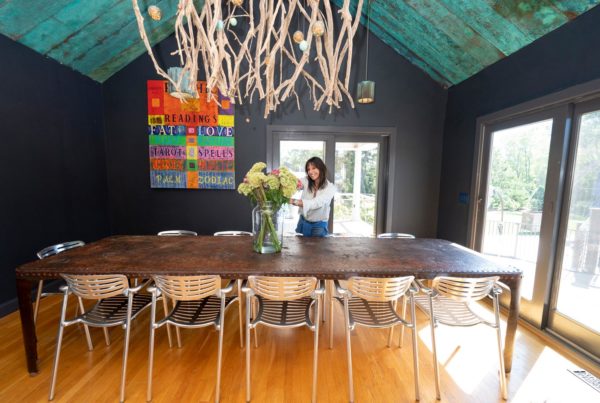SOME BUYERS THINK A FIREPLACE IS A NECESSARY ACCESSORY
The house seemed perfect: three bedrooms near downtown Greenport, ideal for a couple on the cusp of retirement.
But even after they made a bid on the $895,000 property, the couple couldn’t get their minds around one issue. “The house had no fireplace, and that’s what they kept coming back to,” says Sheri Winter Clarry, a Southold-based Corcoran Group broker who helped them find the home. “Without it, the wife felt that the house lacked a feeling of warmth.”
Real estate agents are finding more and more that fireplaces are “must haves” for home buyers. Not only does a hearth make for a cozy centerpiece on cool nights, it can also be a good investment – with each fireplace adding as much as 12 percent to a home’s value when the time comes to sell, according to a recent study by the National Center for Real Estate Research, a Washington, D.C.-based group run through the National Association of Realtors.
Authenticity vs. ease
And these days, there are myriad choices – from traditional wood-burning fireplaces, which are still the most common, to startlingly real-looking gas fireplaces, which many experts say are easier to use and maintain, as well as environmentally friendlier.
“Nine times out of 10, I find that a home buyer will mention that they want a fireplace,” says Shawn Elliott, owner of Shawn Elliott’s Luxury Homes and Estates in Woodbury. “It makes a house a home, and gives it a warmth that another house wouldn’t have.”
There are different schools of thought about which type of fireplace is best. While some people insist on the “authenticity” of a wood-burning fireplace, others prefer something that burns cleaner and takes less work. Gas-burning fireplaces are now dominant among new installations and in newer homes, says Linda Wheeler, a spokeswoman for the Arlington, Va.-based Hearth, Patio and Barbecue Association.
Builder Mike Nobiletti creates wood-burning fireplaces on a grand scale. In his last home, he built a “walk in” 6-by-6-foot fireplace, lined with stone benches where visitors could sit and warm their toes after coming in from the cold. Now, in his palatial 8,000-square-foot North Haven home, he’s built five: in the cellar wine-tasting room, the kitchen, the library, the master bedroom and the living room. All are wood-burning.
The ones in the living room and library are also large in scale – with 6-by-6-foot fireboxes – made from granite, and lined with thin brick in a herringbone pattern. But Nobiletti, who recently put the shingled-style house on the market for $5 million, says he uses the kitchen fireplace most – practically every night as a cozy place to sit with a glass of wine or a spot where guests can curl up after a meal.
“A fireplace is the centerpiece to any home,” Nobiletti says. “It has to be spectacular.”
Love at first sight
Lisa Johnston, 27, doesn’t have 8,000 square feet or a wine-tasting room, but since buying her Tudor home in Hempstead last year, she, too, has found the fireplace a favorite feature.
Johnston says she didn’t even think of wanting one when she started her house hunt. But once she saw it, and imagined stockings hanging from the mantel during the holidays and people curled up there during family gatherings, suddenly she couldn’t imagine how she’d lived without one.
“When I met the previous owner, I remember she said the fireplace was one of the things she was going to miss the most,” says Johnston, who works for the Army in homeland security. “Once you have one, you can’t see being without one.”
Indeed, Rosita Mapp, the Century 21 agent who sold Johnston her home, says many clients don’t start out asking for fireplaces but are hooked once they see their first.
“When they see their first house with a fireplace, it often becomes a conversation point,” she says. “And after that they want to keep seeing homes with fireplaces.”
Elliott, the owner of the Woodbury agency, says he’s met his share of purists who want only a wood-burning fireplace. But he says more and more people are opting for gas, which releases fewer pollutants when burned and requires no lifting or storage of logs.
Richard Deutsch, a chiropractor and inventor who recently put his waterfront home in Islip on the market for $1.26 million, says he and his significant other, Patricia Davis, converted their traditional wood-burning fireplace to gas several years ago after they tired of storing buggy wood in the house and worrying about sparks flying from the hearth onto their Persian rug.
“Not only was a gas fireplace more convenient, but it’s also warmer, and we actually wanted the heat,” says Deutsch. He and Davis made sure the fireplace retained the ability to burn wood, however, should future owners prefer that.
And that’s not all they did.
Deutsch and Davis built a 150-gallon fish tank into the stone wall above the fireplace so they would have something beautiful to gaze at while they warmed themselves by the fire – or even when there is no fire. The result is certainly one of the most unique fireplaces on Long Island, says their real estate agent, Tracy Sobel, who works for Prudential Douglas Elliman in East Islip. Surprisingly, the burning fire doesn’t change the temperature of the fish tank.
Elliott says he opted for a gas-burning fireplace in his home. “I press a remote control, and in two seconds I have an instant fire,” he says.
“I find that people who have had wood-burning fireplaces for a long time – they’re basically getting tired of it,” Elliott says. “Gas fireplaces are zero maintenance. And you wouldn’t believe how authentic they look. Mine even makes a crackling sound.”
Several update options
Possibly an even better reason to go with gas is that wood-burning fireplaces are an environmental hazard – the number-one source of air pollution from residences, according to the federal Environmental Protection Agency.
These days, the EPA has to approve every new fire stove manufactured, and a growing number of municipalities across the country have begun to ban wood burning at certain times to protect air quality.
People who want to update an old, wood-burning fireplace to something that burns cleaner have several options, Wheeler says. There are freestanding wood stoves and fireplace inserts (stoves modified to fit into an existing fireplace), both of which give off less smoke than a traditional fireplace. There are also pellet stoves, which burn recycled sawdust pellets.
Of course, prices for fireplace renovations vary widely, depending on how major the desired change is, and on the condition of the existing fireplace. But Wheeler says it’s often a lot less than people think. Adding a fireplace to a home that doesn’t have one can start as low as $1,000, she says.
In the end, agent Sheri Winter Clarry says she thinks that’s how her Greenport couple is going to resolve their problem.
“They’ve decided to add a fireplace,” she says. “They’ve already scoped out where it’s going to go.”
Inspect to keep home fires burning safely
Anyone considering a home with a fireplace should get a special inspection before they sign on the dotted line, or risk paying big money for repairs later, chimney experts say.
Melissa Heeke, a spokeswoman for the Chimney Safety Institute of America, says poor maintenance can cause flammable debris to build up on the inside of a chimney and eat away at the flue walls. That kind of damage can cost thousands of dollars to repair, and can be a major fire hazard, she says.
A homebuyer should call a certified chimney sweep, listed on the Chimney Safety Institute’s Web site (csia.org), for a “Level Two” inspection, which usually runs about $250 to $300, and includes a thorough external check of the fireplace and chimney, and a video camera check of the chimney’s interior, which could reveal cracks and buildup that would otherwise be missed.
Once a chimney has been thoroughly inspected, all that’s needed is an annual check, and a sweep when necessary, experts say.
John Pilger, who owns Chief Chimney Services in Smithtown, says annual checkups, called “Level One” inspections, run about $85 for inspection alone and $150 with a sweep included. He says gas fireplaces should get checked annually, too, though they’ll probably need to be cleaned only once every two or three years.
Vents to the home’s heating system also should be checked, Pilger says. “You absolutely need to do it,” he says. – ANN GIVENS
Firesides to ignite the market
The floor-to-ceiling wood-burning marble fireplace with solid brass bifold doors inside this Glen Head Tudor, which is listed for $769,000, once looked very different – it had been a Colonial-style red-brick fireplace. Listing agent: Stephen Santoro, Century 21 Jimco Realty, Glen Cove, 516-759-3170.
The white-marble wood-burning fireplace in this Bridgehampton traditional, which is listed for $3.895 million and is in contract, is in the master bathroom. Listing agent: Vincent Horcasitas, Prudential Douglas Elliman Real Estate, Bridgehampton, 631-537-5900.
Both the wood-burning brick fireplace and the built-ins that surround it are said to be original to this 1941 Cedarhurst Colonial, listed for $899,000. Listing agent: Milky Forst Properties, Far Rockaway, 516-239-0306.
The wood-burning fireplace in this Centereach Victorian, which is listed for $579,900, has a Heatilator to circulate the hot air throughout the house. The mantel is made of wood. Listing agent: Connie Yeung, Coldwell Banker Schaefer Tafuro, Holbrook, 631-472-4300.
The fireplace in this Roosevelt Colonial, listed for $410,000, was constructed when the house was built in 1913. The brick is now painted white, although the wood panel above it is the same. Listing agent: Carol Sharpe Byng, Coldwell Banker Residential Real Estate, Ronkonkoma, 631-588-9090.
Copyright 2007 Newsday Inc.








